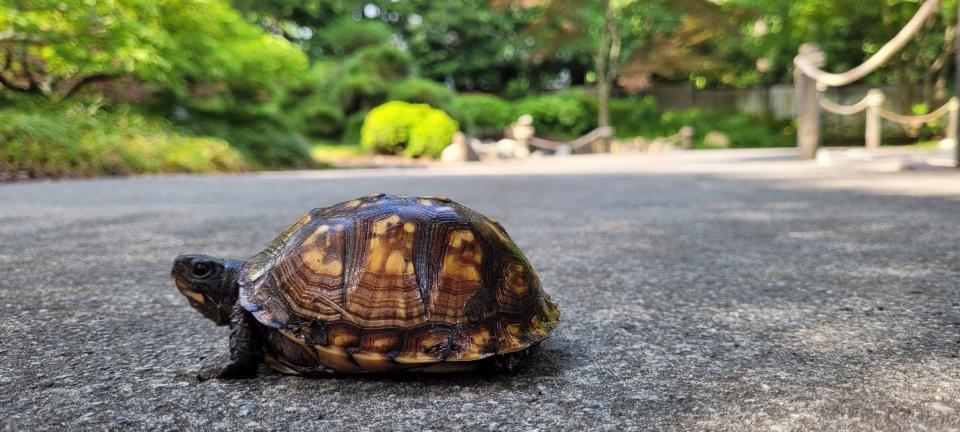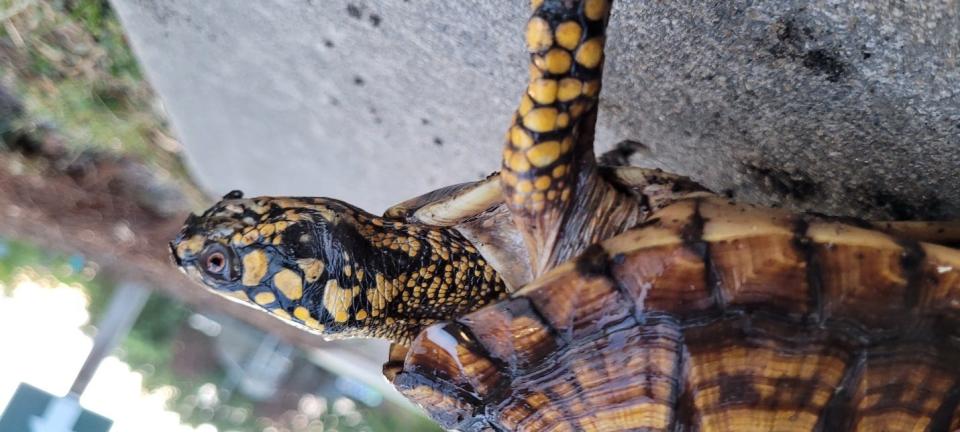Seasonal temperatures mark the arrival of state reptile to New Hanover arboretum
Gardens can be special places to their visitors and curators that offer refuge and solace. For me, a garden is an agreement between wildlife and people – wherein the agreement states that both parties can have their cake and eat it too if both parties agree to a little compromise.
I have the privilege of being on the grounds first thing every morning to witness some of the wild residents that call our gardens home. Our floating wetland islands act like a safe harbor for herons and egrets. Our camellias and other shrubs offer nesting for songbirds. The tall and mature trees provide perching opportunities for hawks as they hunt squirrels. Flower diversity attracts an abundance of pollinators and other insects. If you look closely, you can spot reptiles like anoles, skinks, snakes, and my favorite, the box turtle.

Seasonal temperatures are warming up which means our state reptile, the Eastern box turtle, is looking for vittles, premium nesting real estate, and love in all the right places. Box turtles are a terrestrial species, usually no bigger than a grapefruit, and are closely related to pond turtles. They can swim but do not spend as much time in the water as your typical pond turtle, preferring to wade in shallow waters looking for food. They are most active in the early morning hours when temperatures are cooler. As the day warms, they seek refuge under a shady fern or a clump of grass with arching blades. It is fun to imagine life through their eyes, everything must be so daunting, large, and expansive but equally adventurous. Their territory is typically 6 or 7 acres, the same size as the arboretum, which is why I believe we can remain their home. Habitat loss and fragmentation, illegal collection, road mortality, slow maturity, and nest destruction plague this species like most other species.

Shells and markings are almost always unique to the individual like the fingerprints on you or I. Some are vibrant with stark contrasts between light and dark, others blending of similar shades. Males usually have brighter necks and reddish-orange eyes while females have less flare. The bottom of the shell, the plastron, hinges allowing them to completely seal their extremities inside which is extremely useful should a predator find them. Into summer, females are looking for nesting sites, usually a well-drained and somewhat sandy location - two months later, the nestlings emerge.
Each year, the first full week in May marks the National Eastern Box Turtle Week; please join me as we shell-ebrate our state reptile! If you happen to see one while visiting the gardens here at the arboretum, please, do not touch them, just enjoy the sighting of this lovely creature that calls these gardens home. If you were not lucky enough to spot one, visit our children’s play area where you can climb into a larger-than-life replica of a box turtle shell and try to see the world through their eyes.
More: I don't: A New Hanover public attraction is leaving the wedding business

Kevin Cassel is the grounds supervisor for the New Hanover County Arboretum, located at 6206 Oleander Drive, Wilmington. He can be reached at kcassel@nhcgov.com or 910-798-7660. The gardens are free and open daily from 8 a.m.–5 p.m.
This article originally appeared on Wilmington StarNews: New Hanover Arboretum celebrates National Eastern Box Turtle Week

